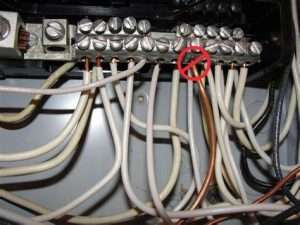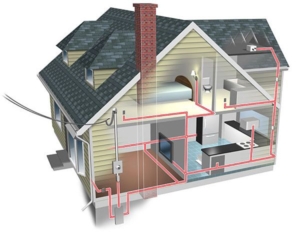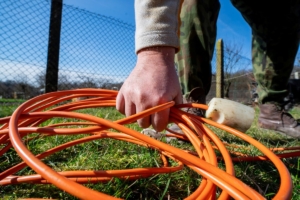Understanding 30 Amp Wire Size:
Choosing the Correct Wire Gauge for Your Circuit
When it comes to wiring your space, knowing the right size is key. This holds especially true for 30 amp wire size. This wire type is often the choice for homes, RVs, and other similar settings. Too small a wire size can lead to overheating and potential fire hazards. On the other hand, a wire size that’s too large can be an unnecessary expense. By the end of this post, you’ll know exactly what size wire you need for a 30 amp circuit. Let’s dive right into the details!
What is 30 Amp Wire Size?
Understanding Electrical Wire Size
When it comes to electrical circuits, understanding wire size ensures safety and proper functionality. Wire size refers to the gauge or thickness of the wire, and it plays a vital role in determining the amount of current that can safely flow through the circuit. In this section, we’ll focus specifically on the 30 amp wire size and its importance.
Importance of Choosing the Correct Wire Size for a 30 Amp Circuit
Selecting the correct wire size for a 30 amp circuit is essential to prevent overheating and potential hazards. Here’s why:
- Safety First: The primary reason for choosing the correct wire size is to maintain safety. When a wire is too small for the amount of current flowing through it, it can overheat and potentially cause fires or damage to electrical equipment. By using the appropriate wire size for a 30 amp circuit, you ensure that the wire can handle the current without getting excessively hot.
- Efficient Performance: Using the correct wire size also ensures optimal performance of your electrical system. When wires are too small, they can create resistance, leading to voltage drops and reduced efficiency. By selecting the right wire size for a 30 amp circuit, you allow electricity to flow smoothly and efficiently, minimizing energy waste.
- Compliance with Codes and Standards: Building codes and industry standards specify the minimum wire size required for different circuit amperages. Adhering to these guidelines not only ensures safety but also keeps you in compliance with legal requirements. Using the correct 30 amp wire size helps you meet the standards set forth by regulatory bodies.
- Avoiding Electrical Failures: Inadequate wire size can lead to frequent tripping of circuit breakers or blowing of fuses. This inconvenience can disrupt your daily activities and constantly replacing fuses or resetting breakers can become frustrating. By utilizing the appropriate wire size for a 30 amp circuit, you reduce the risk of electrical failures and the associated inconveniences.
Remember, electrical work should be undertaken by professionals for safety reasons.
Factors to Consider When Choosing 30 Amp Wire Size
Choosing the appropriate wire size is crucial when it comes to electrical installations. Whether you’re working on a residential or commercial project, selecting the right wire size ensures safety and efficiency. In this section, we will discuss the key factors to consider when choosing a 30 amp wire size.
Ampacity and Current-Carrying Capacity
The ampacity of a wire refers to its ability to carry electrical current without overheating. When selecting a wire size for a 30 amp circuit, it’s essential to choose one with an ampacity rating that exceeds the circuit’s current requirement. This ensures that the wire can handle the load without getting dangerously hot.
In terms of current-carrying capacity, the wire should be able to handle the maximum current that will flow through it. For a 30 amp circuit, the wire should have a current-carrying capacity of at least 30 amps. It’s important to note that the current-carrying capacity of a wire depends on its gauge, material, and insulation type.
Voltage Drop Considerations
Voltage drop is another factor to consider when choosing the wire size for a 30 amp circuit. Voltage drop occurs when the electrical current encounters resistance as it travels through the wire. Excessive voltage drop can lead to poor performance of electrical devices or equipment.
To minimize voltage drop, it’s recommended to select a wire size that keeps the voltage within an acceptable range. The longer the wire run, the higher the resistance, and consequently, the higher the voltage drop. Using larger gauge wire can reduce voltage drop, ensuring that your electrical system operates efficiently.
Type of Wiring Material
The type of wiring material you choose for your 30 amp circuit will depend on various factors, including the installation environment and local electrical codes. Common wiring materials for 30 amp circuits include copper and aluminum.
Copper wire is widely used due to its excellent conductivity and resistance to corrosion. It is an ideal choice for most residential applications. Aluminum wire, on the other hand, is more economical and suitable for larger installations. However, it requires special connectors and careful installation to prevent issues such as oxidation.
When selecting the wiring material, consult with a qualified electrician or refer to local electrical codes to ensure compliance and safety.
Wire Gauge Options for 30 Amp Circuits
The wire gauge determines the amount of current that can safely pass through the wire, preventing overheating and potential hazards. In this section, we will discuss the recommended wire gauges for different materials, such as copper and aluminum, as well as the guidelines set forth by the National Electrical Code (NEC) for 30 amp wire sizes.
Recommended Wire Gauges for Different Materials
Copper Wire
Copper is a popular choice for electrical wiring due to its excellent conductivity and durability. For a 30 amp circuit, the recommended wire gauge for copper is typically 10 AWG. This gauge is capable of handling the higher current without excessive voltage drops or heat buildup. It is essential to choose a wire gauge that matches the ampacity requirements of your circuit to ensure safe and reliable operation.
Aluminum Wire
While copper is commonly used, aluminum wire can also be utilized for 30 amp circuits. However, due to its lower conductivity compared to copper, aluminum wire requires a larger gauge to achieve the same ampacity. For a 30 amp circuit using aluminum wire, it is recommended to use 8 AWG. This larger gauge compensates for the lower conductivity of aluminum, ensuring efficient current flow and minimizing potential issues.
National Electrical Code (NEC) Guidelines for 30 Amp Wire Size
The NEC is a comprehensive set of electrical standards and guidelines that are widely adopted across the United States. It provides specific requirements for wire sizing to promote safety and consistency in electrical installations. When it comes to 30 amp wire size, the NEC prescribes the following guidelines:
- For copper wire: 10 AWG is the minimum required wire gauge for a 30 amp circuit. This ensures that the wire can handle the current without exceeding its ampacity rating.
- For aluminum wire: 8 AWG is the minimum required wire gauge for a 30 amp circuit using aluminum wire. Again, this compensates for the lower conductivity of aluminum and maintains safe operation.
It is important to note that these guidelines serve as a minimum requirement. In certain situations, such as long wire runs or specific installation conditions, it may be advisable to use a larger wire gauge to further minimize voltage drops and ensure optimal performance.
Selecting the appropriate wire gauge for a 30 amp circuit is crucial to ensure safety and prevent potential issues. For copper wire, 10 AWG is typically recommended, while for aluminum wire, 8 AWG is the preferred choice. By adhering to the guidelines set forth by the NEC, you can be confident in the reliability and efficiency of your electrical installation.
How to Calculate Wire Size for a 30 Amp Circuit
When it comes to electrical wiring, it’s important to ensure that you select the correct wire size for your circuit. In this section, we will guide you through the process of calculating the wire size for a 30 amp circuit. We will cover three key factors: using the ampacity chart, considering the length of the circuit, and factoring in voltage drop. By following these steps, you can ensure the safety and efficiency of your electrical system.
Using the Ampacity Chart
The first step in determining the appropriate wire size for a 30 amp circuit is to consult the ampacity chart. This chart provides information on the maximum current that a particular wire size can safely carry. It is important to select a wire size that can handle the current without overheating.
To use the ampacity chart, locate the column that corresponds to the type of wire you plan to use. Then, find the row that matches the temperature rating of the wire. Keep in mind that higher temperatures may require larger wire sizes. Once you have identified the correct row and column, look for the maximum ampacity value. This value represents the maximum current that the wire can safely carry.
Considering the Length of the Circuit
The length of the circuit also plays a role in determining the appropriate wire size for a 30 amp circuit. As the length of the circuit increases, the resistance of the wire also increases. This can result in a voltage drop, which can affect the performance of the electrical system.
To account for voltage drop, it is recommended to use a wire size that compensates for the length of the circuit. One way to calculate the appropriate wire size is to use voltage drop tables or calculators. These tools take into account the length of the circuit, the current, and the desired voltage drop. By entering these values, you can determine the appropriate wire size to minimize voltage drop.
Factoring in Voltage Drop
Voltage drop refers to the decrease in voltage that occurs as current flows through a wire. Excessive voltage drop can lead to inefficient operation of electrical devices and can potentially cause damage to sensitive equipment.
To minimize voltage drop, it is important to select a wire size that can handle the current without significant voltage loss. In addition to using voltage drop tables or calculators, you can also refer to the National Electrical Code (NEC) guidelines for recommended voltage drop limits. These limits vary depending on the type of circuit and the application.
By considering the length of the circuit and factoring in voltage drop, you can ensure that the wire size for your 30 amp circuit is appropriate. This will help maintain the safety and efficiency of your electrical system.
Remember, when working with electricity, it is always recommended to consult a qualified electrician to ensure compliance with local electrical codes and regulations.
Common Applications for 30 Amp Circuits
In residential and commercial settings, 30 amp circuits are commonly utilized to power specific electrical devices or systems that require a higher level of electrical current. These circuits are designed to handle a maximum load of 30 amps, providing a safe and efficient power supply for various applications. In this section, we will explore the common residential and commercial applications for 30 amp circuits.
Residential Applications
In residential environments, 30 amp circuits play a crucial role in powering specific appliances and systems that demand a higher electrical load. Here are some common residential applications where 30 amp circuits are commonly used:
- Electric Dryers: Electric dryers require a significant amount of power to generate the heat necessary for drying clothes effectively. A 30 amp circuit provides the necessary electrical current to operate these appliances safely and efficiently.
- Electric Ranges: Electric ranges, also known as electric stoves, rely on 30 amp circuits to power the cooking elements and other features. These circuits ensure that the range receives an adequate supply of electricity, enabling it to reach the desired temperature quickly and maintain consistent heating during cooking.
- Hot Tubs: Hot tubs or spas often require 30 amp circuits to power the heating elements, pumps, and other electrical components. These circuits ensure that the hot tub operates reliably and delivers the desired temperature for a relaxing and enjoyable experience.
- Garage or Workshop Outlets: Many homeowners have dedicated workshops or garages where heavy-duty power tools and machinery are used. 30 amp circuits provide the necessary electrical capacity to support these tools, ensuring proper operation and preventing circuit overload.
Commercial Applications
In commercial settings, 30 amp circuits are employed to meet the higher electrical demands of various equipment and systems. Here are some common commercial applications where 30 amp circuits are frequently utilized:
- Commercial Kitchen Appliances: Restaurants, cafes, and other food establishments often use commercial-grade kitchen appliances that require a 30 amp circuit. These appliances include ovens, grills, fryers, and other cooking equipment that necessitate a robust power supply for efficient operation.
- HVAC Systems: Heating, ventilation, and air conditioning (HVAC) systems in commercial buildings often require 30 amp circuits to power the compressors, fans, and other components. These circuits ensure that the HVAC system can deliver the necessary heating or cooling capacity to maintain a comfortable indoor environment for occupants.
- Data Centers: Data centers house numerous servers, networking equipment, and storage systems that demand a substantial amount of power. 30 amp circuits are commonly used to provide the high electrical current required to support the operation of these critical IT infrastructure components.
- Commercial Grade Power Tools: Construction sites, manufacturing facilities, and workshops often rely on commercial-grade power tools. These tools, such as large saws, drills, and welding equipment, require 30 amp circuits to deliver the necessary power for heavy-duty tasks.
Safety Considerations for Installing 30 Amp Wiring
When it comes to installing 30 amp wiring, safety should always be a top priority. Whether you’re setting up a new electrical circuit or upgrading an existing one, it’s crucial to follow proper installation techniques, adhere to grounding and bonding requirements, and consult a licensed electrician. In this section, we’ll delve into these key safety considerations to ensure a secure and reliable electrical setup.
Proper Installation Techniques
Proper installation techniques are vital to ensure the safe and efficient operation of your 30 amp wiring. Here are some essential guidelines to follow:
- Plan and design: Before starting the installation, carefully plan and design the circuit layout. Consider the power requirements, load calculations, and the specific electrical devices or appliances that will be connected to the circuit.
- Use appropriate wire size: Selecting the correct wire size is crucial for safety and preventing overheating. In the case of 30 amp wiring, a minimum wire size of 10 AWG (American Wire Gauge) is typically recommended. Using the appropriate wire size ensures that the circuit can handle the current without excessive voltage drop.
- Secure connections: When making electrical connections, ensure they are secure and tight. Loose connections can lead to overheating and potential hazards. Use wire nuts, terminal blocks, or appropriate connectors based on the specific application.
- Protective measures: Install appropriate protective measures such as circuit breakers or fuses to prevent overloading and potential electrical fires. These devices are designed to detect excessive current and interrupt the circuit to protect against damage and hazards.
Grounding and Bonding Requirements
Proper grounding and bonding are essential for the safe and effective operation of any electrical system. Here’s what you need to know:
- Grounding: Grounding provides a safe pathway for electrical currents to flow into the ground in the event of a fault or malfunction. Ensure that the 30 amp wiring system is properly grounded, connecting all metallic components to a grounding electrode system or grounding conductor.
- Bonding: Bonding involves connecting all non-current carrying metal parts of the electrical system together to establish electrical continuity and prevent the buildup of voltage differences. Bonding is crucial for safety, especially in situations where electrical faults or lightning strikes can occur.
Importance of Consulting a Licensed Electrician
While DIY projects can be tempting, it’s crucial to recognize when you should consult a licensed electrician. Here’s why it’s important:
- Safety expertise: Licensed electricians have the necessary expertise and knowledge to assess and tackle electrical projects safely. They understand the intricacies of electrical systems and can ensure that your 30 amp wiring installation meets all safety standards.
- Code compliance: Electrical work is subject to specific electrical codes and regulations. A licensed electrician is well-versed in these codes and can ensure that your installation meets all relevant requirements. This not only ensures safety but also avoids potential legal issues in the future.
- Peace of mind: Hiring a licensed electrician provides peace of mind, knowing that the job will be done correctly and safely. They have the experience and training to handle any unforeseen challenges that may arise during the installation process.
In conclusion, when it comes to installing 30 amp wiring, following proper installation techniques, adhering to grounding and bonding requirements, and consulting a licensed electrician are crucial for safety and peace of mind. By prioritizing these safety considerations, you can ensure a reliable and secure electrical setup in your home or building.
Conclusion
In conclusion, selecting the appropriate wire size for a 30 amp circuit is crucial to ensure safety and efficiency. It is essential to consider factors such as the distance between the power source and the load, the type of wire insulation, and the voltage drop. By adhering to the National Electrical Code (NEC) guidelines and consulting with a qualified electrician, you can determine the correct wire size for your specific application.
Remember, undersized wires can lead to overheating and potential fire hazards, while oversized wires may result in unnecessary expenses and wasted resources. Therefore, it is vital to strike the right balance and choose the right wire gauge for your 30 amp circuit.
When it comes to wire sizing for a 30 amp circuit, it is essential to prioritize safety, efficiency, and compliance with electrical codes. By taking the necessary precautions and seeking professional advice, you can confidently select the appropriate wire size for your specific needs.









